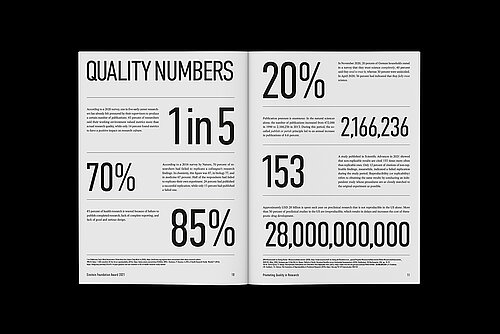
1 in 5
According to a 2020 survey, one in five early career researchers has already felt pressured by their supervisors to produce a certain number of publications. 43 percent of researchers said their working environment valued metrics more than actual research quality, while only 14 percent found metrics to have a positive impact on research culture.
(Wellcome Trust: What Researchers Think About the Culture They Work In (2020), wellcome.org/reports/what-researchers-think-about-research-culture )
70%
According to a 2016 survey by Nature, 70 percent of researchers had failed to replicate a colleague’s research findings. In chemistry, this figure was 87, in biology 77, and in medicine 67 percent. Half of the respondents had failed to replicate their own experiment. 24 percent had published a successful replication, while only 13 percent had published a failed one.
(M. Baker: 1,500 scientists lift the lid on reproducibility (2016), www.nature.com/articles/533452a)
85%
85 percent of health research is wasted because of failure to publish completed research, lack of complete reporting, and lack of good and serious design.
(I. Chalmers, P. Glasziou: Is 85% of Health Research Really “Wasted”? (2016), blogs.bmj.com/bmj/2016/01/14/paul-glasziou-and-iain-chalmers-is-85-of-health-research-really-wasted)
20%
In November 2020, 20 percent of German households stated in a survey that they trust science completely, 40 percent said they tend to trust it, whereas 30 percent were undecided. In April 2020, 36 percent had indicated that they fully trust science.
(Wissenschaft im Dialog/Kantar: Wissenschaftsbarometer (2020), www.wissenschaft-im-dialog.de/fileadmin/user_upload/Projekte/Wissenschaftsbarometer/Bilder/Wissenschaftsbarometer_ 2020/20_Wiba_2020_Vertrauen.jpg)
2,166,236
Publication pressure is enormous: In the natural sciences alone, the number of publications increased from 472,086 in 1990 to 2,166,236 in 2013. During this period, the so-called publish or perish principle led to an annual increase in publications of 6.6 percent.
(I.A. Moosa, Publish or Perish: Perceived Benefits versus Unintended Consequences (2018), Cheltenham, UK/Northampton, USA, pp. 18-19)
153
A study published in Scientific Advances in 2021 showed that non-replicable results are cited 153 times more often than replicable ones. Only 12 percent of citations of non-replicable findings, meanwhile, indicated a failed replication during the study period. Reproducibility (or replicability) refers to obtaining the same results by conducting an independent study whose procedures are as closely matched to the original experiment as possible.
(M. Serra-Garcia, U. Gneezy: Nonreplicable Publications Are Cited More Than Replicable Ones (2021), www.ncbi.nlm.nih.gov/pmc/articles/PMC8139580/; 28,000,000,000 L.P. Freedman)
28,000,000,000
Approximately USD 28 billion is spent each year on preclinical research that is not reproducible in the US alone. More than 50 percent of preclinical studies in the US are irreproducible, which results in delays and increases the cost of therapeutic drug development.
(I.M. Cockburn, T.S. Simcoe: The Economics of Reproducibility in Preclinical Research (2015), doi.org/10.1371/journal.pbio.1002165)

